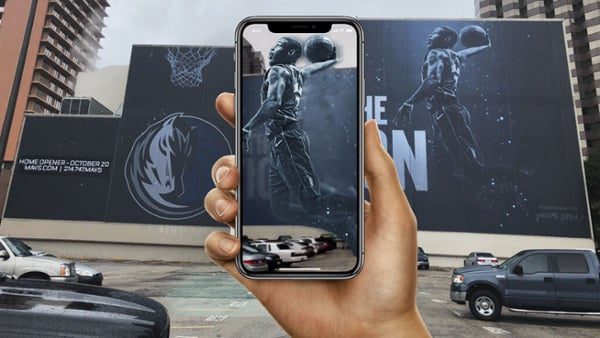If you’ve already checked out our new report, Rising Above Digital Fatigue with OOH, you know that 84% of marketers across the country expect OOH to become more interactive in 2022. Of that group, nearly two-thirds said they are particularly interested in learning how augmented reality (AR) can help activate their out-of-home ads.
So what’s so hot about AR?
Marketers often use storytelling to help potential customers imagine themselves interacting with the brand’s products or services. People who can picture successfully using and benefiting from the product are more likely to seek further information and buy.
Augmented reality is a game-changer because it’s hands-on. Ad viewers become users, literally stepping into the picture. They can try things on, or try them out. It’s the next best thing to being there in the store, showroom, etc.
Or, maybe even better because, let’s face it. AR is a lot more fun.
What is augmented reality?
It’s easy to assume that augmented reality and virtual reality are the same thing. But they are not.
- Virtual reality takes you to a place that is 100% imaginary, and you have to wear special goggles to get there.
- Augmented reality combines the here-and-now with imaginary digital elements.
Some AR applications use modified glasses to add those imaginary elements, but AR can also work via specialized apps or on any smartphone, using the phone front- or rear-facing camera.
OOH has a unique ability to connect the physical and digital worlds for consumers. Augmented reality adds action and creates captivating, immersive experiences that are uniquely personalized.
The viewer controls what they see, and the content is all about them.
- They can explore features to see how products look on their body or in their home.
- They can do a virtual walk-around or customize a product.
- They may find themselves joined by digitally-created objects or people right where they stand in their real world surroundings.
Augmented reality OOH isn’t all that new
Back in 2014, Timberland hung a digital screen in a store-front window and invited after-hours passersby to use their “Magic Mirror” to virtually try on different outfits. The screen scanned each person and their movements, then displayed selected apparel on a similar body type. Shoppers could save their favorites and receive them via email for purchase or social sharing.
More recent technology advancements have dramatically upgraded augmented reality from an amusing novelty available only to big-budget brands into a mainstream advertising asset.
There were about 1 billion AR app downloads in 2016. That number is expected to exceed 5.5 billion this year.
Now-widespread 5G wireless connectivity enables users to connect quickly to multiple devices, so mobile devices (and apps) can work with OOH ads to create the desired AR experience. This increased accessibility for consumers makes AR more versatile and cost-effective for marketers.
Adding AR is easy
Adding a QR code is a simply way to incorporate AR into your OOH ad. With that, you can expand almost any stationary out-of-home ad into an augmented reality experience. Billboards and street furniture, place-based DOOH screens – anywhere the viewer can reach out and scan your ad to activate the experience.
What’s not to like?
- AR is useful. Personalized ads and interactions help consumers make better shopping decisions, ensuring they will be happy with their purchase. Of course, AR can be fantastically entertaining as well as practical.
- Multi-sensory experiences are not only more engaging, they are more memorable. Ads that incorporate augmented reality can extend dwell times and boost brand recognition and recall. According to L’Oréal, adding AR technology can double engagement time and triple conversion rates.
- The experience is eminently sharable, generating greater reach, brand advocacy and advertising ROI.
- The same advanced technology that enables users to access AR also enables marketers to track user engagement using location data.
- Consumers like it. Some brands introduced consumers to AR during the pandemic, as a way to boost online engagement and sales.
- 44% have virtually tried on clothes on an online site
- 69% then purchased the product online or in store
- 77% of those who have not yet used virtual try-on would do so if it were easy to access
- 78% of consumers would rather interact with an AR experience than watch a 30-second video
- Those who have experienced augmented reality say their experience made them smile or laugh. It improved their mood. Nearly half said they stayed engaged longer than they had intended.
- And they shared their experience, especially in pictures. AR technology with built-in personalization and social media hyperlinks makes it even easier to share the experience.
What can you do with augmented reality?
- Pepsi turned the window of a bus shelter into a looking glass that randomly displayed a variety of other-worldly, 3D scenes which realistically blended with the actual street view outside the window. Their ad generated 3 million YouTube views in 5 days.
- Jackson Family Wines pinot noir label Siduri used a QR code on both billboards and wine bottles that users could scan to see a photo-realistic hologram of company founder Adam Lee.
- Burger King famously used augmented reality in their “Burn this Ad” campaign that invited consumers to digitally set fire to competitors’ ads in return for a reward.
- Ally Bank placed three dozen “collectable” Monopoly game board squares on sidewalks in 6 US cities. Users could scan the squares to find Mr. Monopoly handing out cash prizes as well as points. The treasure hunt racked up more than 100,000 plays, and 86% of players collected all 36 squares.
AR is fun
Marketers in our nationwide survey said they are looking to out-of-home to revitalize relationships with digitally exhausted audiences. Why? Because OOH surprises and delights better than any other channel. Augmented reality not only adds new levels of surprise and delight, it can engage audiences longer and more effectively.
